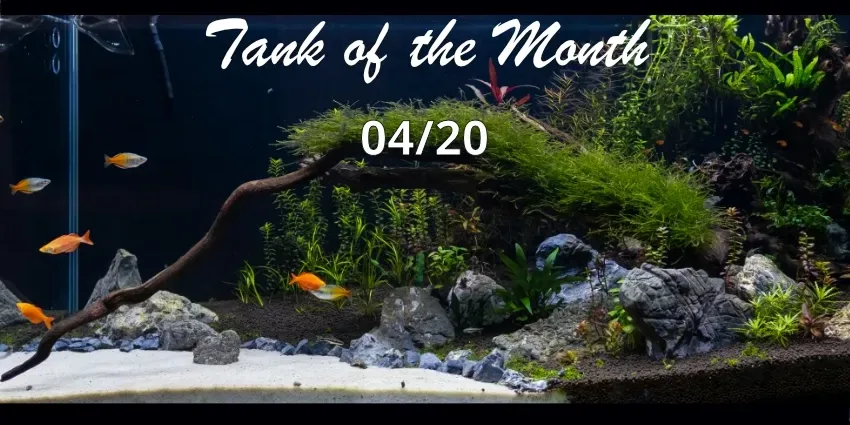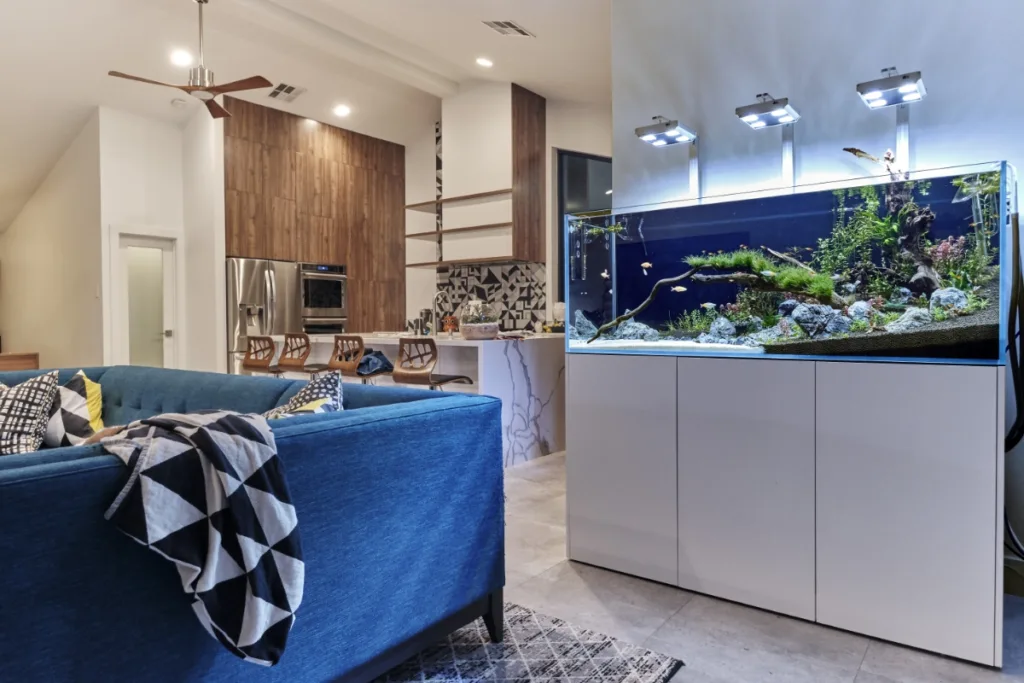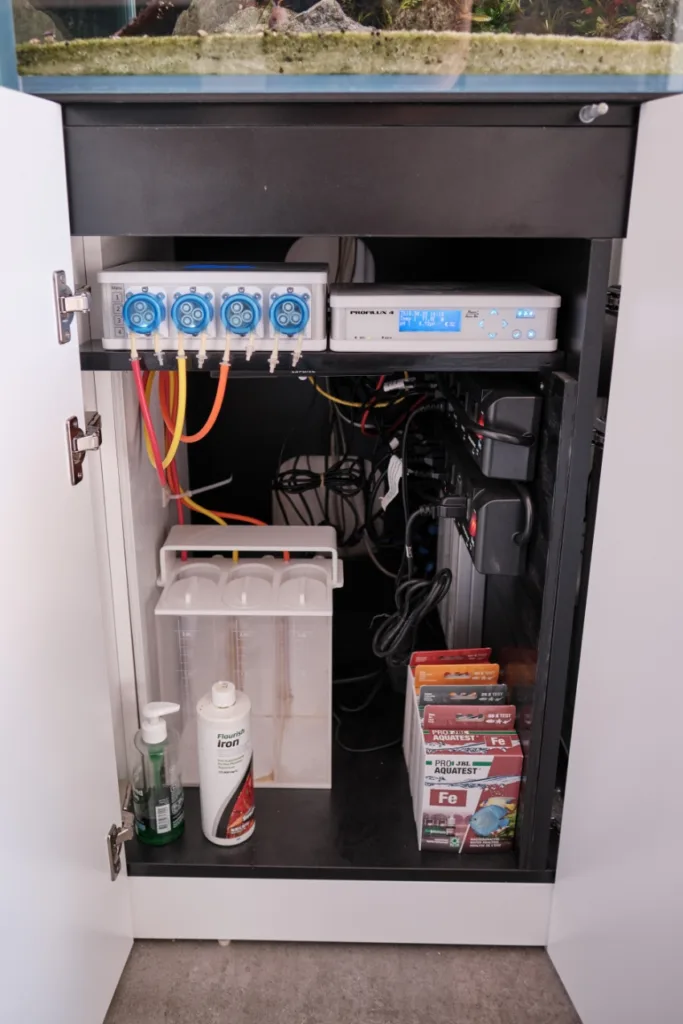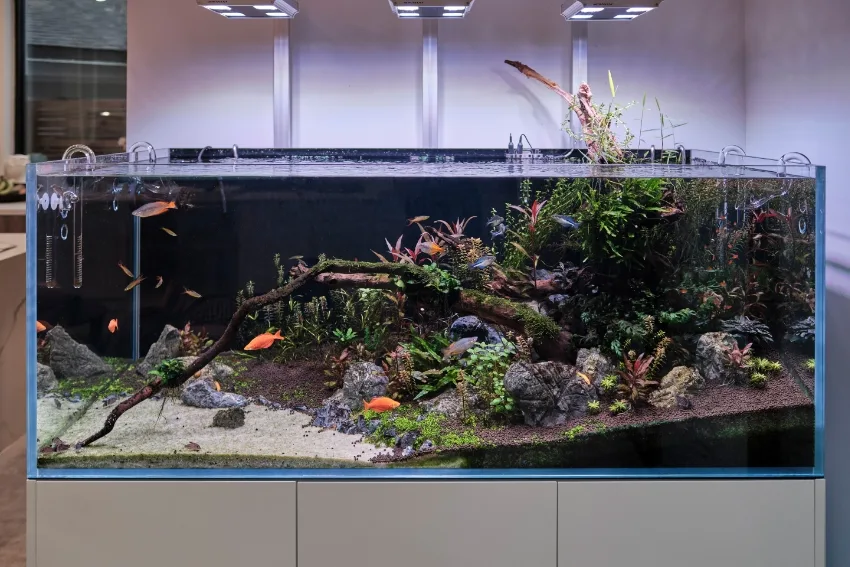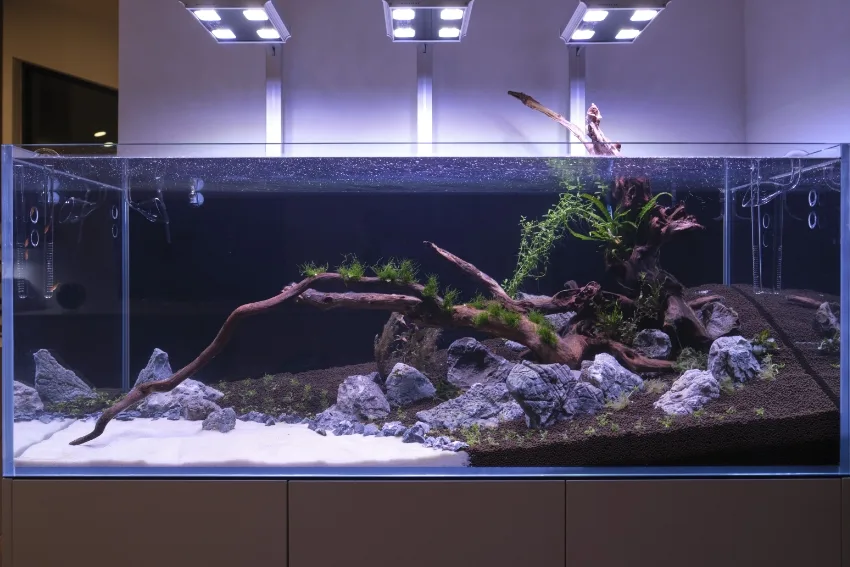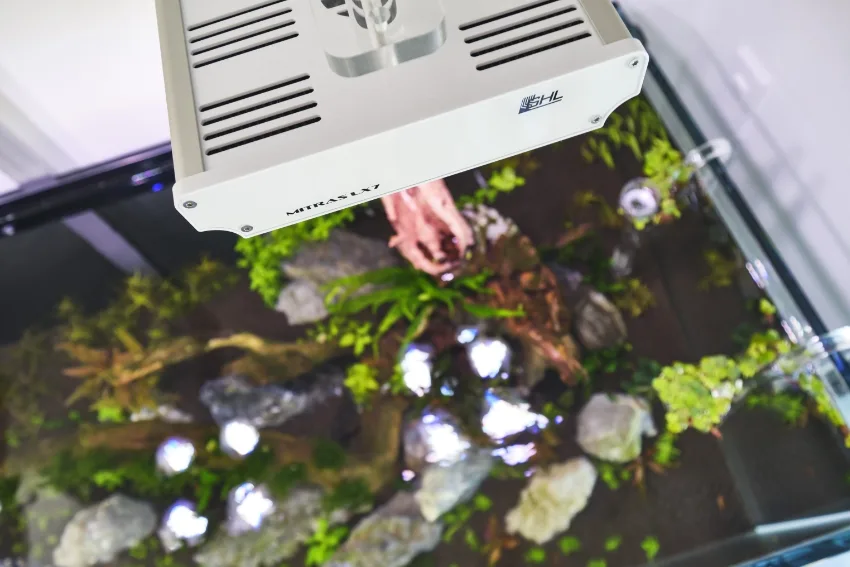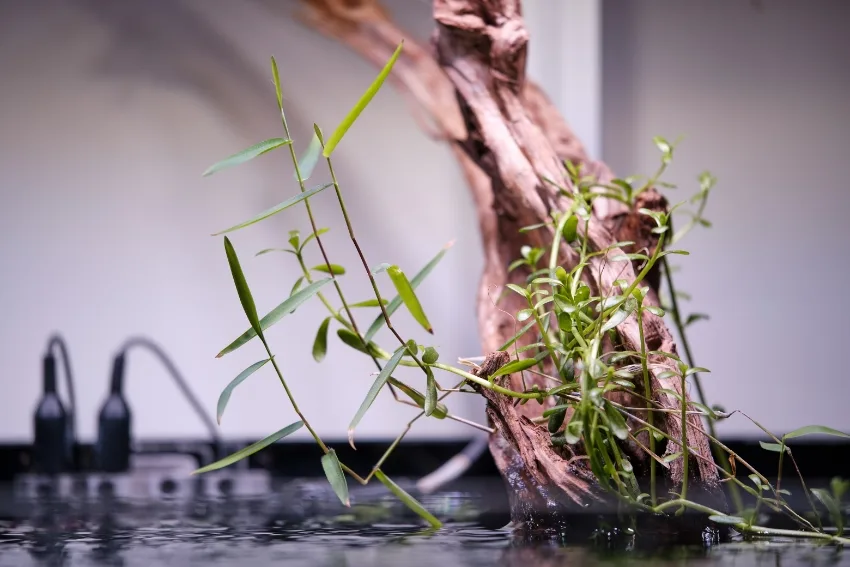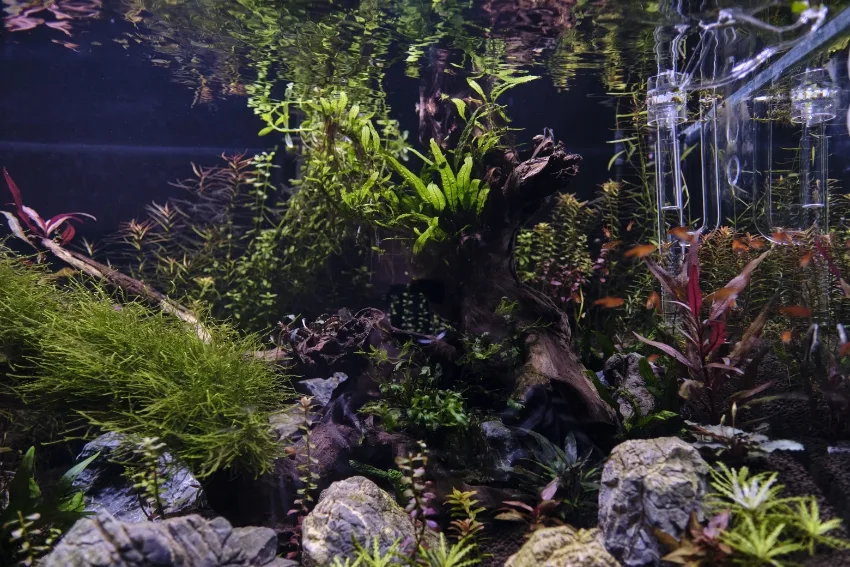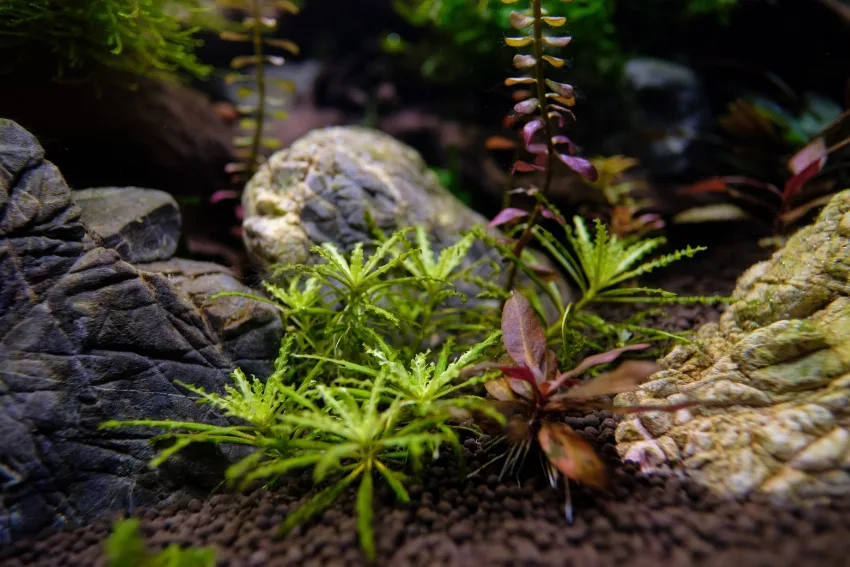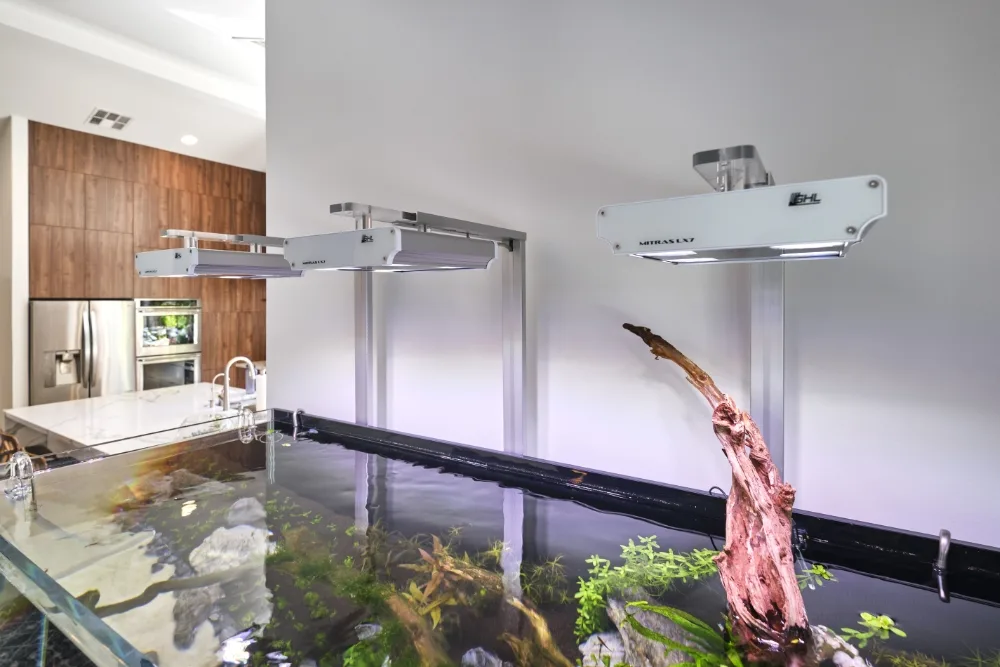Dennis DeSilva’s 143-gallon freshwater tank, run by the GHL System
- Tank owner: Dennis DeSilva
- Location: Houston, Texas
- Display volume: 650 liters / 143 gallons
- Display size: 1.5m x 0.64m x 0.61m / approx: 60in x 25in x 24in
Freshwater Planted Tank
Hello, my name is Dennis DeSilva and I’m from Houston, Texas. Like many hobbyists, I had various simple freshwater setups as a kid.
As an adult and newly married, I decided to give saltwater reefing a try. As with most things in life, I tend to jump in the whole hog. I went to my LFS and had them set me up with a 150g. This was way back… before Facebook groups, and forums were still fairly young.
I had no idea what I was doing. And the biggest problem was the lack of funds. Buying live rock a little bit at a time, not understanding the needs of various coral, anemones, etc. I definitely bit off more than I could chew. A pretty common story in the hobby, unfortunately. So I sold it all and forgot about it for several years.
My start with GHL
A little over a decade ago, I found myself in a better place. Better financially, smarter, and better-informed thanks to the increase of online information. I decided this time I was going to start small and DIY.
I bought 45g bow front, built my own stand, put together the sump, skimmer and other equipment myself, plumbed it myself, even installed a T5 retrofit kit in the DIY hood. I wouldn’t call this tank a roaring success, but I was definitely on the right path, and I learned a ton.
That knowledge was applied to the next tank. And what I learned from that build was applied to the next, and so on. I was planning my 3rd tank in 2012, and this was when I found GHL.
I was looking for a new controller, and after much research, it was obvious to me that GHL was the way to go. They weren’t the cheapest, and they weren’t the easiest to get here in the USA at the time, but from what I could see, they were the most reliable.
When you are dealing with thousands of dollars in livestock, not to mention all the blood, sweat, and tears, why would I choose anything else?
Time for a change
Fast forward to 2019. A remodel of our home forced me to temporarily move my current tank to a different part of the house. After the remodel was complete, I decided that over a decade of reefing was enough. I was getting a bit bored and felt like I needed a new challenge.
I still wanted an aquarium and ended up doing what many people would probably feel is going backwards… I decided to jump into the world of the Planted Freshwater Aquarium.
Knowing myself, I knew I couldn’t just tip-toe into it. I was going to cannonball right into the deep end. I thought to myself, how can I take what I know from a decade of Reef tanks and apply that to a planted aquarium?
The basics are the same. Water quality, husbandry, etc. The dedication is the same.
Knowing I would be using as much GHL as possible,
I got a 143g aquarium from Waterbox and started planning the build with P4 Controller, GHL Doser 2.1, Mitras LX7 Led lighting, and accessories.
And here we are: This tank got wet around mid-October of 2019, so right about five months ago as of this writing.
I did not do a dry start,
I was filling and planting at the same time. The plants were planted in 2 or 3 stages over the course of several weeks, and every now and then, I have added another species.
I do not try to emulate any particular style, ie. Dutch, Iwagumi, etc. One of my favorite parts of creating new aquarium builds is the aquascaping, and I just go by feel.
This tank is still in its infancy, and I’m currently at a stage where I am trying to balance everything. Light intensity, Co2, dosing, and algae.
Being my first real planted aquarium, I’m fairly pleased with the results so far, but I know I still have a heck of a lot to learn and figure out as I move forward.
One thing is for sure… The GHL lighting grows plants, and the ProfiLux keeps everything running without a hitch.
Automation with GHL
Controllers are not nearly as popular on freshwater systems, but after running my reefs with GHL, I knew I had to use my ProfiLux on this system as well.
First and foremost, there is the added security and peace of mind that it brings. At any time, from just about anywhere, I can check in on the tank. I have email alerts set up to warn me of any problems. And I have a Nest camera pointed at the tank so I can get a quick visual if needed.
Second, I automate my auto top-off and my water changes.
The ATO is pretty standard, using the basic ATO feature in the ProfiLux 4, but since I do not have a sump on this system, I had to install the sensor (and probes) in the display tank.
For water changes, I have the ProfiLux performing 8 small water changes per day.
It only changes a couple of liters at a time, and somewhere close to 7 gallons per day. All I need to do is make sure there is plenty of water available. I have two 60g storage tanks. One holds fresh RO/DI water for the ATO, and the other holds water RO/DI water that has been remineralized for the water changes.
I use the timer function in the P4 to turn on an old Cole Parmer Masterflex peristaltic pump with dual heads. The lines run to opposite sides of my tank. As one line is pulling out the old water, the other line is pushing in new water.
These pumps are very precise and are changing out equal amounts of water. My water is stored outside here in Houston in a protective shed. Temperature does not matter since the amount of water is so small.
I’ve been doing auto water changes like this in some form for many years now, and it has worked flawlessly. In the event I do need to do a large water change, the storage tanks are close enough for me to run a hose.
The Co2 comes on about an hour and a half before the lights come on and turn off an hour before lights go out. I use Programmable Logic in the P4 to give the Co2 the start and end time and also control the solenoid with the pH probe. My pH is set to 6.6 which is just over a 1 point pH drop.
For dosing, I am using the GHL Doser 2.1. It is hooked up but not being utilized just yet. I used an activated soil in the tank (Ultum ControSoil) which has been handling the bulk of my nutrients thus far. Occasionally I will hand dose a little bit of fertz or other nutrients from Tropica, Fluval, etc. But I am nearing the point of exhausting the soil so I will be implementing the Doser soon for more consistent dosing of fertilizers.
Many may think my lighting is a bit overkill for a planted tank, but I knew I wanted QUALITY above all else.
GHL does not disappoint. The Mitras are built like tanks, and their software is extremely feature-rich. The plants you see in the photos were grown with just a fraction of the power that is available, and they are hung about 15” off the surface of the water. I’m currently in the process of slowly increasing intensity each week to further increase plant health. And as with their reef lights, the freshwater versions have 9 channels of LED to fully customize the spectrum throughout the photoperiod. There aren’t many options out there for freshwater that have this type of capability, let alone to the extent of the Mitras.
I’m using the heaters that are integrated with the canister filters, but they are controlled by the ProfiLux. If they ever malfunction and get stuck on, the ProfiLux will kill the power to those sockets.
Livestock
Livestock: Plants
- Anubias
- Bucephalandra
- Alteranthera
- Cryptocoryne
- Microsorum
- Pogostemon
- Bolbitis
- Taxiphyllum
- Micranthemum
- And more…
Livestock: Fish
- Boesemani Rainbows
- Albino Millenium Rainbows
- Turquoise Rainbows
- Parkesoni Rainbows
- Ember Tetras
- Cory Catfish
- Golden Chinese Algae Eaters
- Amano Shrimp
Invertebrates:
- 50+ Amano Shrimp
Equipment Overview
- Aquarium and Stand – Waterbox Clear Pro 6025 – 60”x25”x24”h
- Lighting – (3) GHL Mitras LX 7004 mounted to GHL Flex Mounts
- Controller – GHL ProfiLux 4 with (3) Powerbars, Temp Probe, pH Probe, Optical Level Sensor
- Doser – GHL Doser 2.1
- Filtration – (2) Oase Biomaster 600 Thermo with (2) sets of JARDLI Glass Pipes
- Flow – (1) Tunze Turbelle 6105
- Co2 – Co2 Art Regulator, 5lb Co2 tank, Nilocg Reactor

